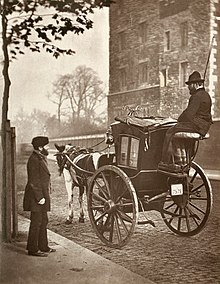
A carriage is a two- or four-wheeled horse-drawn vehicle for passengers. Second-hand private carriages were common public transport, the equivalent of modern cars used as taxis. Carriage suspensions are by leather strapping or, on those made in recent centuries, steel springs. Two-wheeled carriages are usually owner-driven.

A hackney or hackney carriage is a carriage or car for hire. A hackney of a more expensive or high class was called a remise. A symbol of London and Britain, the black taxi is a common sight on the streets of London. The hackney carriages carry a roof sign TAXI that can be illuminated to indicate their availability for passengers.
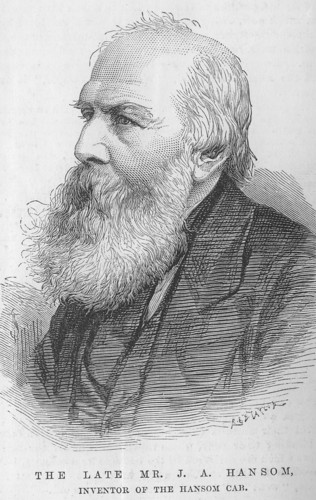
Joseph Aloysius Hansom was a British architect working principally in the Gothic Revival style. He invented the Hansom cab and founded the eminent architectural journal The Builder in 1843.

A coachman is an employee who drives a coach or carriage, a horse-drawn vehicle designed for the conveyance of passengers. A coachman has also been called a coachee, coachy,whip, or hackman.

A brougham was a light, four-wheeled horse-drawn carriage built in the 19th century. It was named after the politician and jurist Lord Brougham, who had this type of carriage built to his specification by London coachbuilder Robinson & Cook in 1838 or 1839. It had an enclosed body with two doors, like the rear section of a coach; it sat two, sometimes with an extra pair of fold-away seats in the front corners, and with a box seat in front for the driver and a footman or passenger. Unlike a coach, the carriage had a glazed front window, so that the occupants could see forward. The forewheels were capable of turning sharply. A variant, called a brougham-landaulet, had a top collapsible from the rear doors backward.
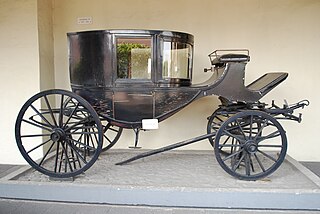
A clarence is a type of carriage that was popular in the early 19th century. It is a closed, four-wheeled horse-drawn vehicle with a projecting glass front and seats for four passengers inside. The driver sat at the front, outside the carriage. The clarence was named after Prince William, Duke of Clarence and St Andrews, later King William IV of the United Kingdom, who died in 1837. It was introduced in 1840 in London. The Brougham was a lighter, two-passenger version originally commissioned by Lord Brougham.

A horse-drawn vehicle is a piece of equipment pulled by one or more horses. These vehicles typically have two or four wheels and were used to carry passengers or a load. They were once common worldwide, but they have mostly been replaced by automobiles and other forms of self-propelled transport but are still in use today.

A dogcart is a two-wheeled horse-drawn vehicle pulled by a single horse in shafts, or driven tandem. With seating for four, it was designed for sporting shooters and their gun dogs, with a louvred box under the driver's seat to contain dogs. It was developed in the early 1800s to afford more seating than the gig, which seats only two. Seating is two back-to-back crosswise seats, an arrangement called dos-à-dos from French. There is a hinged tailboard which lowers slightly and, supported by chains, acts as a footrest for the rear-facing passengers. Some dogcarts had a mechanism to slide the entire body forward or rearward along the shafts to help balance the weight for the horse.
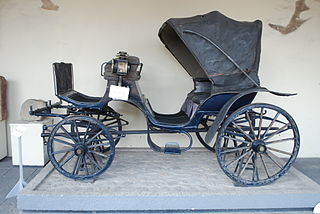
The victoria is an elegant style of doorless four-wheeled open carriage, drawn by one or two horses, based on the phaeton with the addition of a coachman's seat at the front, and with a retractable roof over the passenger bench.
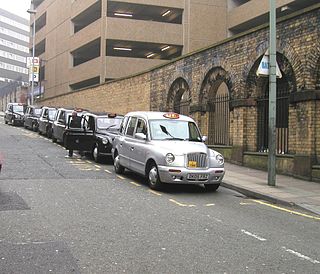
Taxicabs are regulated throughout the United Kingdom, but the regulation of taxicabs in London is especially rigorous with regard to mechanical integrity and driver knowledge. An official report observed that: "Little however is known about the regulation by anyone outside the trade. The Public Carriage Office (PCO), which regulates and licenses taxis and private hire was transferred from the Metropolitan Police to become part of Transport for London in 2000." In 2015, there were around 298,000 licensed drivers in England, of which 164,000 were private hire licences, 62,000 were taxi licences and 72,000 were dual licences.

A herdic was a type of horse-drawn carriage, which was frequently used as an omnibus during the late nineteenth and early twentieth centuries. It was invented by Peter Herdic of Williamsport, Lycoming County, Pennsylvania during the 1870s and patented in 1880.

Taxis in Australia are highly regulated by each Australian state and territory, with each state and territory having its own history and structure. In December 2014, there were 21,344 taxis in Australia. Taxis in Australia are required to be licensed and are typically required to operate and charge on a fitted taximeter. Taxi fare rates are set by State or Territory governments. A vehicle without a meter is generally not considered to be a taxi, and may be described, for example, as a hire car, limousine, carpool, etc. Most taxis today are fueled by liquid petroleum gas. A2B Australia owns and operates the Cabcharge payment system, which covers 98% of taxis in Australia, and operates one of Australia's largest taxi networks.

The Electrobat was one of the first electric automobiles. It was designed and built in 1894 by mechanical engineer Henry G. Morris and chemist Pedro G. Salom in Philadelphia, Pennsylvania.

A coach is a large, closed, four-wheeled, passenger-carrying vehicle or carriage usually drawn by two or more horses controlled by a coachman, a postilion, or both. A coach has doors in its sides and a front and a back seat inside. The driver has a raised seat in front of the carriage to allow better vision. It is often called a box, box seat, or coach box. There are many types of coaches depending on the vehicle's purpose.

A cabriolet is a light horse-drawn vehicle, with two wheels and a single horse. The carriage has a folding hood that can cover its two occupants, one of whom is the driver. It has a large rigid apron, upward-curving shafts, and usually a rear platform between the C springs for a groom. The design was developed in France in the eighteenth century and quickly replaced the heavier hackney carriage as the vehicle for hire of choice in Paris and London.

The Remington Carriage Museum is located in Cardston, Alberta, Canada. Opened in 1993, and the largest of its kind in the world, the Remington Carriage Museum displays more than 240 carriages.

A taxi, also known as a taxicab or simply a cab, is a type of vehicle for hire with a driver, used by a single passenger or small group of passengers, often for a non-shared ride. A taxicab conveys passengers between locations of their choice. This differs from public transport where the pick-up and drop-off locations are decided by the service provider, not by the customers, although demand responsive transport and share taxis provide a hybrid bus/taxi mode.

A horse-bus or horse-drawn omnibus was a large, enclosed, and sprung horse-drawn vehicle used for passenger transport before the introduction of motor vehicles. It was mainly used in the late 19th century in both the United States and Europe, and was one of the most common means of transportation in cities. In a typical arrangement, two wooden benches along the sides of the passenger cabin held several sitting passengers facing each other. The driver sat on a separate, front-facing bench, typically in an elevated position outside the passengers' enclosed cabin. In the main age of horse buses, many of them were double-decker buses. On the upper deck, which was uncovered, the longitudinal benches were arranged back to back.

The Bayswater Omnibus is an 1895 oil painting by George William Joy. It has been part of the Museum of London's collection since 1966. The genre painting depicts a scene inside a horse-drawn omnibus of the London General Omnibus Company. Joy borrowed a bus from the company while he was working on his painting.
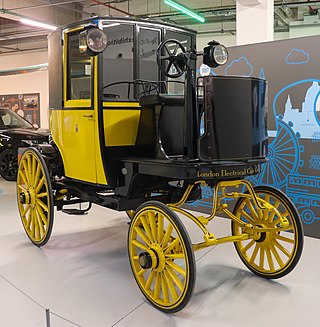
The Bersey Electric Cab was an early electric-powered vehicle and the first electric taxi cab in London. Developed by Walter Bersey the vehicles reportedly had a top speed of 12 mph (19 km/h) and could carry two passengers. An initial service of 12 cabs began on 19 August 1897 and a total of 77 were built, with a maximum of 75 in service at once. They were initially popular and were nicknamed "hummingbirds" for the sound they made and their distinctive livery. The vehicles suffered badly from wear in service owing to their heavy weight. This damaged the batteries and tyres, which were expensive to replace, and made their operation unprofitable. The cabs were withdrawn in August 1899 and electric cabs did not return to the streets of London until the Nissan Dynamo was introduced in October 2019.


